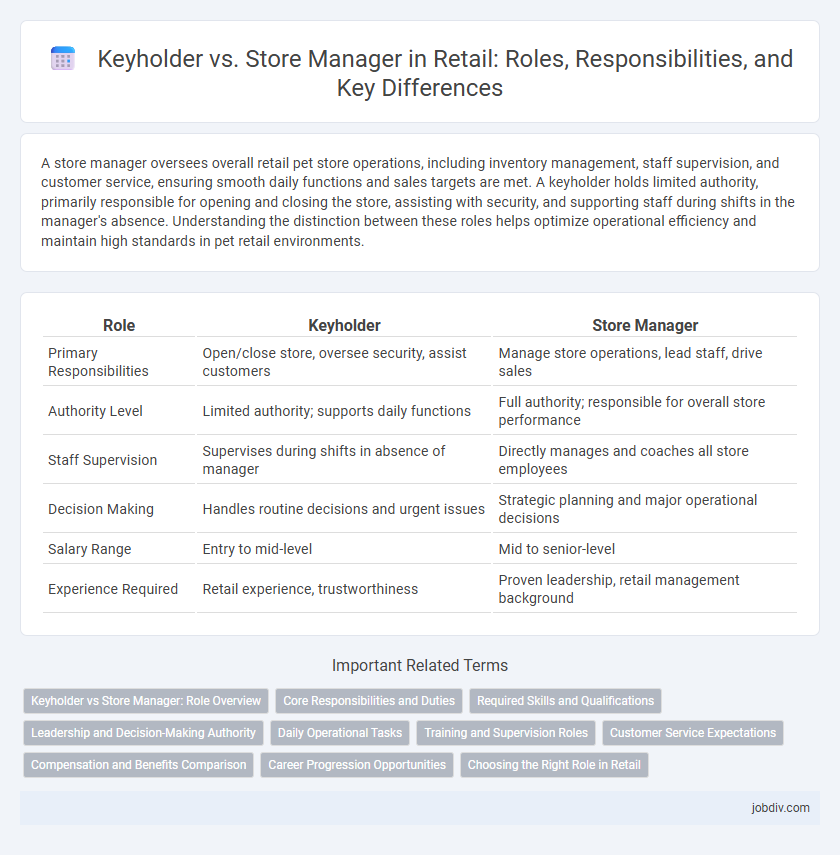A store manager oversees overall retail pet store operations, including inventory management, staff supervision, and customer service, ensuring smooth daily functions and sales targets are met. A keyholder holds limited authority, primarily responsible for opening and closing the store, assisting with security, and supporting staff during shifts in the manager's absence. Understanding the distinction between these roles helps optimize operational efficiency and maintain high standards in pet retail environments.
Table of Comparison
| Role | Keyholder | Store Manager |
|---|---|---|
| Primary Responsibilities | Open/close store, oversee security, assist customers | Manage store operations, lead staff, drive sales |
| Authority Level | Limited authority; supports daily functions | Full authority; responsible for overall store performance |
| Staff Supervision | Supervises during shifts in absence of manager | Directly manages and coaches all store employees |
| Decision Making | Handles routine decisions and urgent issues | Strategic planning and major operational decisions |
| Salary Range | Entry to mid-level | Mid to senior-level |
| Experience Required | Retail experience, trustworthiness | Proven leadership, retail management background |
Keyholder vs Store Manager: Role Overview
Keyholders are entrusted with opening and closing responsibilities, ensuring store security during non-managerial hours, and supporting daily operational tasks, while store managers oversee overall store performance, including staffing, sales targets, inventory management, and customer satisfaction. Keyholders act as vital support in maintaining store operations and assisting staff, whereas store managers hold primary accountability for strategic decisions and operational leadership. Understanding these distinct roles enhances workforce efficiency and clarity in retail management structures.
Core Responsibilities and Duties
Keyholders are responsible for opening and closing the store, securing premises, handling cash transactions, and assisting customers during shifts, while store managers oversee overall store operations, including sales targets, staff management, inventory control, and implementing company policies. Store managers develop team schedules, conduct performance evaluations, and drive marketing strategies to boost store profitability. The core distinction lies in the scope of leadership, with keyholders supporting operational tasks and store managers directing strategic business goals.
Required Skills and Qualifications
Keyholders must demonstrate strong organizational abilities, customer service expertise, and trustworthiness, often requiring basic retail experience and knowledge of opening and closing procedures. Store managers require advanced leadership skills, inventory management capabilities, and a proven track record in meeting sales targets, typically holding several years of retail management experience and relevant certifications. Both roles demand excellent communication skills and the ability to handle cash management, but store managers take on broader responsibilities including staff supervision and strategic planning.
Leadership and Decision-Making Authority
Keyholders assume leadership roles with limited decision-making authority, often responsible for opening and closing stores and supervising staff during shifts. Store Managers hold comprehensive leadership responsibilities, overseeing daily operations, driving sales targets, and making strategic decisions that impact overall store performance. The Store Manager's role commands full accountability for team management, financial outcomes, and implementation of corporate policies.
Daily Operational Tasks
Keyholders oversee opening and closing procedures, manage cash registers, and assist with inventory control to ensure smooth daily operations. Store Managers handle broader responsibilities including staff scheduling, sales target tracking, and overall store performance evaluation. While keyholders execute essential operational duties, store managers focus on strategic planning and employee management.
Training and Supervision Roles
Keyholders support store managers by providing essential training to new employees, focusing on daily operational tasks and customer service standards. Store managers oversee comprehensive training programs, ensuring staff development aligns with company goals and retail compliance. Both roles involve supervising associates, but store managers handle higher-level performance management and strategic planning.
Customer Service Expectations
Keyholders are expected to deliver attentive customer service by assisting shoppers with product knowledge and resolving minor issues on the floor, enhancing the overall shopping experience. Store Managers oversee customer service standards, ensuring staff training and implementation of protocols that uphold high satisfaction levels and handle escalated customer concerns effectively. Both roles prioritize fostering a welcoming environment, with the Store Manager focusing on strategic service leadership and the Keyholder emphasizing hands-on, day-to-day customer interaction.
Compensation and Benefits Comparison
Store Managers in retail typically earn higher base salaries than Keyholders, reflecting their broader responsibilities in operations and staff management. In terms of benefits, Store Managers often receive enhanced healthcare packages, performance bonuses, and retirement plan contributions not commonly extended to Keyholders. Keyholders may receive basic benefits and occasional overtime pay but generally lack the comprehensive compensation structure afforded to Store Managers.
Career Progression Opportunities
Keyholders serve as entry-level leaders responsible for opening, closing, and supporting daily store operations, gaining critical hands-on experience in retail management. Store Managers oversee overall store performance, staff management, and sales targets, representing the next significant step in retail career progression with increased responsibilities and strategic decision-making. Advancing from Keyholder to Store Manager enables professionals to develop leadership skills, improve operational knowledge, and increase earning potential within the retail sector.
Choosing the Right Role in Retail
Keyholders provide essential support by managing store operations during off-peak hours and unlocking the premises, while store managers oversee overall business performance, staff management, and customer experience. Choosing the right retail role depends on career goals: keyholders are ideal for gaining operational experience and flexibility, whereas store managers pursue leadership responsibilities and strategic decision-making. Understanding the distinct responsibilities and growth potential helps align your choice with long-term retail ambitions.
Keyholder vs Store Manager Infographic

 jobdiv.com
jobdiv.com